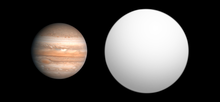astro.wikisort.org - Meteorite
HAT-P-8b is an extrasolar planet located approximately 720 light years away in the constellation of Pegasus, orbiting the 10th magnitude star GSC 02757-01152. This planet was discovered by transit on December 5, 2008. Despite the designation as HAT-P-8b, it is the 11th planet discovered by the HATNet Project. The mass of the planet is 50% more than Jupiter while the radius is also 50% more than Jupiter. The mass of this planet is exact since the inclination of the orbit is known, typical for transiting planets. This is a so-called “hot Jupiter” because this Jupiter-like gas giant planet orbits in a really close torch orbit around the star, making this planet extremely hot (in the order of a thousand kelvins). The distance from the star is roughly 20 times smaller than that of Earth from the Sun, which places the planet roughly 8 times closer to its star than Mercury is from the Sun. The “year” on this planet lasts only 3 days, 1 hour, 49 minutes, and 54 seconds, compared with Earth's 365 days, 6 hours, 9 minutes, and 10 seconds in a sidereal year.[4]
 Size comparison of HAT-P-8b with Jupiter. | |
| Discovery | |
|---|---|
| Discovered by | HATNet Project |
| Discovery date | December 5, 2008 |
Detection method | Transit |
| Orbital characteristics | |
Semi-major axis | 0.04496+0.00046 −0.00045 AU |
| Eccentricity | <0.0060[1] |
Orbital period (sidereal) | 3.0763458±0.0000024[2] d |
| Inclination | 87.5+1.9 −0.9 |
| Star | GSC 02757-01152 |
| Physical characteristics | |
Mean radius | 1.334±0.013 RJ[3] |
| Mass | 1.354±0.035[1] MJ |
The study in 2012, utilizing a Rossiter–McLaughlin effect, have determined the planetary orbit is mildly misaligned with the rotational axis of the star, misalignment equal to -17+9.2
−11.5°.[5]
References
- Bonomo, A. S.; et al. (2017). "The GAPS Programme with HARPS-N at TNG . XIV. Investigating giant planet migration history via improved eccentricity and mass determination for 231 transiting planets". Astronomy and Astrophysics. 602. A107. arXiv:1704.00373. Bibcode:2017A&A...602A.107B. doi:10.1051/0004-6361/201629882.
- Mancini, L.; et al. (2013). "A lower radius and mass for the transiting extrasolar planet HAT-P-8 b". Astronomy and Astrophysics. 551. A11. arXiv:1212.3701. Bibcode:2013A&A...551A..11M. doi:10.1051/0004-6361/201220291.
- Wang, Xian-Yu; et al. (1 July 2021). "Transiting Exoplanet Monitoring Project (TEMP). VI. The Homogeneous Refinement of System Parameters for 39 Transiting Hot Jupiters with 127 New Light Curves". The Astrophysical Journal Supplement Series. 255 (1). 15. arXiv:2105.14851. Bibcode:2021ApJS..255...15W. doi:10.3847/1538-4365/ac0835.
- Latham, David W.; et al. (2009). "Discovery of a Transiting Planet and Eight Eclipsing Binaries in HATNet Field G205". The Astrophysical Journal. 704 (2): 1107–1119. arXiv:0812.1161. Bibcode:2009ApJ...704.1107L. doi:10.1088/0004-637X/704/2/1107.
- Obliquities of Hot Jupiter host stars: Evidence for tidal interactions and primordial misalignments, 2012, arXiv:1206.6105
External links
![]() Media related to HAT-P-8 b at Wikimedia Commons
Media related to HAT-P-8 b at Wikimedia Commons
- "HAT-P-8b light curve using differential photometry". Exoplanets.
- "HAT-P-8 b". Exoplanets. Archived from the original on 2012-03-18. Retrieved 2009-01-01.
На других языках
- [en] HAT-P-8b
[ru] HAT-P-8 b
HAT-P-8b — экзопланета, расположенная на расстоянии 750 световых лет в созвездии Пегаса и вращающаяся вокруг звезды десятой звёздной величины GSC 02757-01152. Планета была открыта с помощью транзитного метода в декабре 2008 года. Несмотря на своё обозначение, планета была одиннадцатой, открытой в рамках Проекта HATNet. Планета в полтора раза массивнее Юпитера, в то время как и радиус планеты превышает юпитерианский в полтора раза. Масса планеты достоверно определена, так как точно известен наклон орбиты, что характерно для транзитных планет. Планета относится к типу горячих юпитеров из-за своего близкого расположения к собственной звезде, что делает температуру на поверхности крайне высокой (возможно несколько тысяч градусов по Кельвину). Расстояние между планетой и звездой в 20 раз меньше того, что разделяет Солнце и Землю, и в 8 раз меньше расстояния между Солнцем и Меркурием. «Год» на этой планете составляет 3 дня 1 час 49 минут и 54 секунды[1].Другой контент может иметь иную лицензию. Перед использованием материалов сайта WikiSort.org внимательно изучите правила лицензирования конкретных элементов наполнения сайта.
WikiSort.org - проект по пересортировке и дополнению контента Википедии